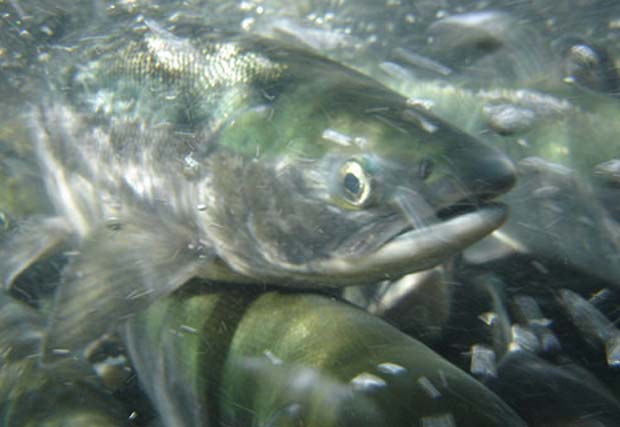Posted by Teresa Haugh, U.S. Forest Service, Alaska / April, 2014
[dropcap]A[/dropcap]laska’s Chugach and Tongass national forests are sometimes referred to as salmon forests, producing all five species of wild Pacific salmon: king, coho, sockeye, pink, and chum.
Salmon is vital to Alaska’s economy, and last year’s statewide commercial salmon harvest is being noted as a banner year. The Alaska Department of Fish and Game announced the salmon harvested in 2013 set a new record at 272 million fish.
About 45 percent, or 122 million, of these commercially harvested salmon relied on habitat managed by the U.S. Forest Service. Much of the harvest consisted of pink salmon, the most abundant of salmon found in Alaska. Don Martin, the aquatic and fish program leader for the Alaska Region, said that 95 percent of the habitat where pink salmon spawn in Southeast Alaska is on the Tongass National Forest. The work of Forest Service fish biologists contribute to the health and viability of these salmon.
“We have never been able to say, ‘We did this work, therefore, there are this many more salmon,’ ” Martin said. “What we do to contribute to the well-being of the salmon is to maintain their habitat. Science has taught us that good habitat means higher fish production, so we bank on that.”
Currently, the vast majority of the watersheds on the Chugach and Tongass national forests function very well. The region is working to restore the few watersheds that do not function well. During logging activities 40 to 60 years ago, trees were harvested right up to the edge of salmon streams. When all that wood was removed from the floodplain, eventually the logs in the creek rotted away, and there were none to replace them. This led to habitat degradation.
Fortunately, Forest Service fish biologists have been successful in restoration efforts. Martin explained that for certain-sized streams at certain gradients, logs are a key component needed to maintain the number and frequency of pools found within the stream. The salmon, particularly coho salmon, need this environmental complexity in their habitat to thrive.
“We are actually going into the streams with big equipment and finding large pieces of wood in the watershed or elsewhere, and placing them in the creeks,” Martin said. “We are building log jams and big root wads to immediately add back the complexity of the creek. We work to restore a natural cycle so that by the time that wood starts to rot out, there will be big trees next to the creek that will fall in and take its place.”
“The effectiveness of watershed restoration can be seen immediately.” Martin said.
“The next year after the first high water event, we can go see that there are more pools, and deeper pools. It just looks like better habitat,” he said. “The big question is whether the logs will stay in the stream long enough for the forest to grow back and begin contributing fallen logs back into the stream. That’s probably 60 or 70 years down the road.”
The region’s Fisheries and Watershed Program work with Alaska Native organizations and individuals, incorporating their cultural beliefs into the forest’s salmon and fisheries management programs. A short video provides more information on how Forest Service involvement in a monitoring program provides salmon for people across the country as well as Haida Alaska Natives who call the forest home.
People around the world can watch the annual Alaska salmon run as they make the pilgrimage to their final spawning grounds before they die. In 2013, viewers logged more than 10,000 hours watching the Tongass National Forest’s live streaming Salmon Cam, making it the most popular Forest Service-related video on YouTube.
Watch for the live cam to return in mid-summer 2014.

Forest Service employees Don Martin and John Lane inspect an in-stream restoration structure on 12-mile Creek, Prince of Wales Island. (U.S. Forest Service/Ron Medel)
To visit ISDA website click here . . .


